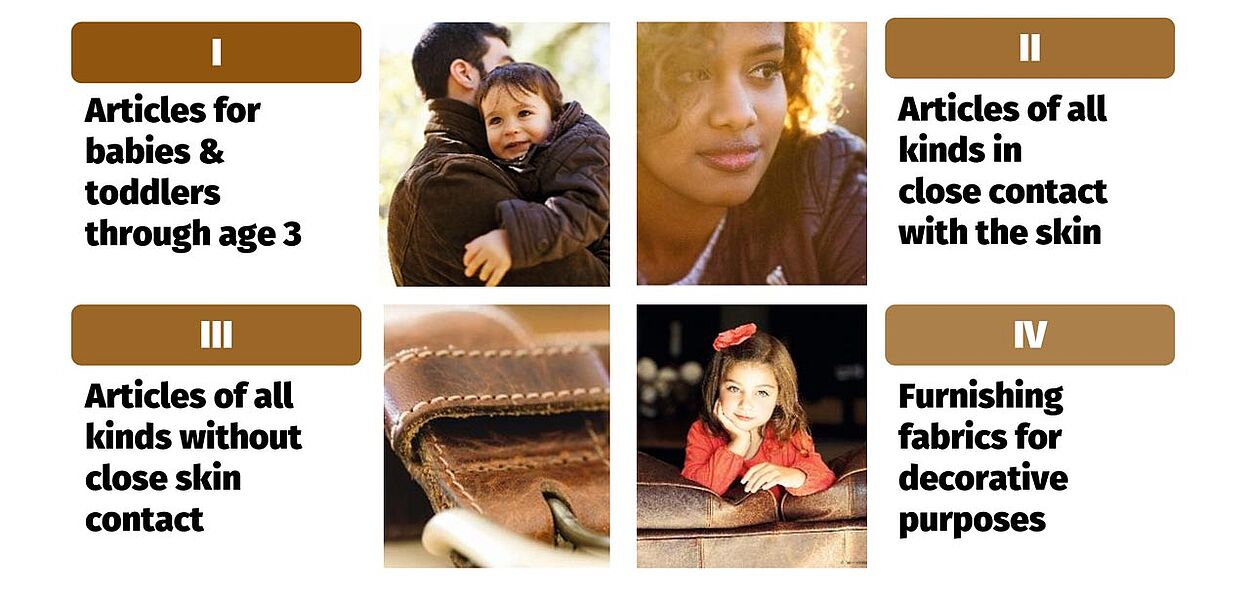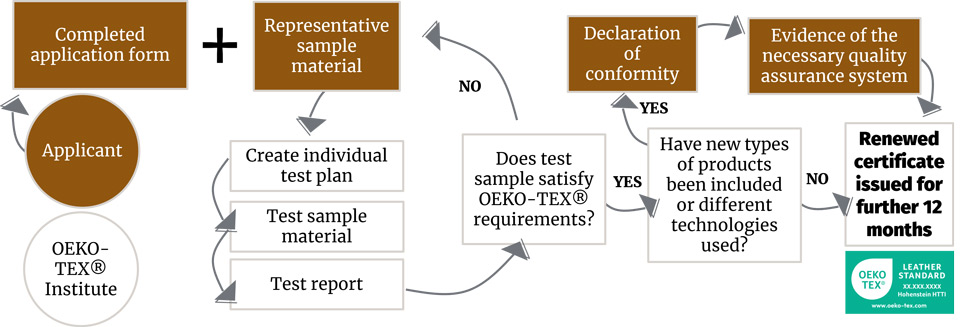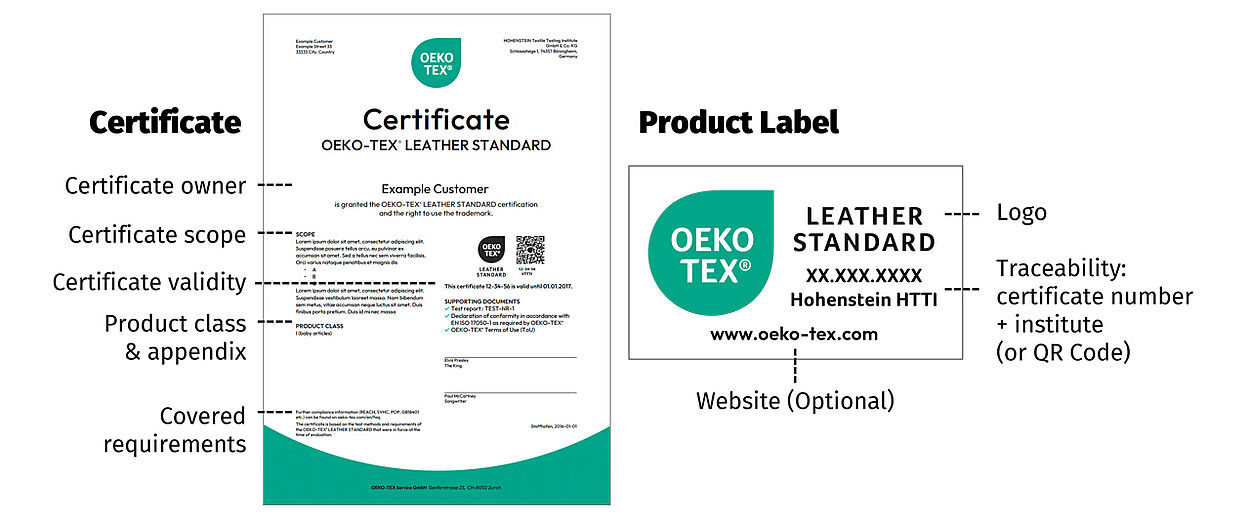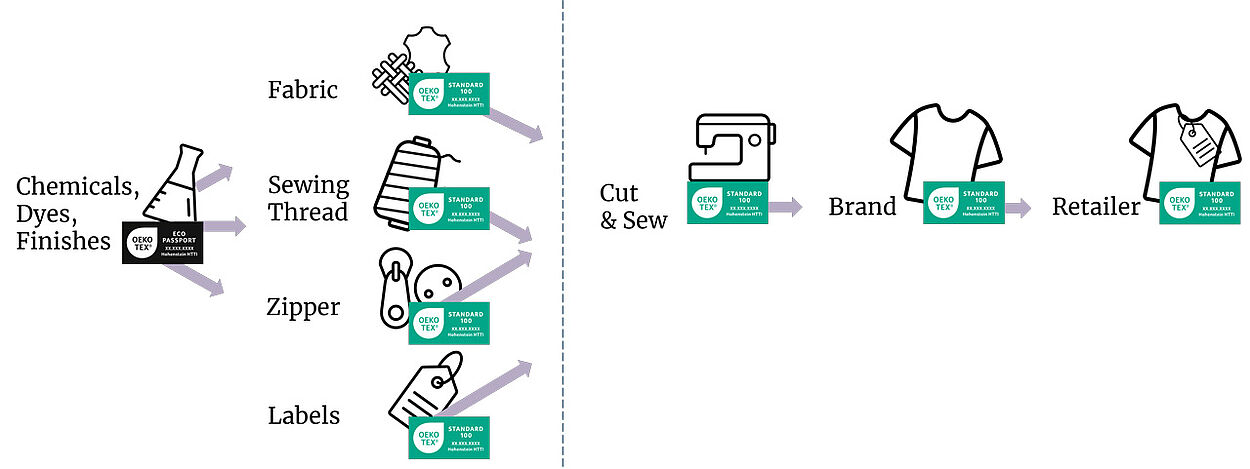What does OEKO-TEX® LEATHER STANDARD do?
- Gives consumers and purchasers a reliable, 3rd-party label for non-hazardous products that are tested in accordance with strict global standards to protect from harmful substances in leather
- Provides targeted product stewardship support for companies in the leather chain with human-ecological product safety, based on a scientific criteria catalogue and neutral laboratory tests
- Simplifies and accelerates supplier relationships for manufacturers and retailers who want to ensure product safety for their customers
- Ensures legal conformity for importers, retailers and manufacturers
What claim does LEATHER STANDARD certify?
OEKO-TEX® LEATHER STANDARD certification means that a product, material, accessory or other leather good, has been tested for substances that could harm human health. This standard protects people from toxics that are left on the product.
To make the claim on a finished good, the product and each of its components/inputs must be tested. This means claims of certification on ingredients (e.g. "the suede in this product is certified") are NOT allowed.
Although a product that is safer for humans could also be better for the planet, LEATHER STANDARD is not an eco/sustainability claim. Sustainability is verified through the OEKO-TEX® MADE IN GREEN label, of which LEATHER STANDARD is an important part.
What is tested for LEATHER STANDARD certification?
The OEKO-TEX® criteria catalogue contains a wide variety of test parameters that consider all ways a substance can be absorbed (skin, mouth, breathing). The central components of LEATHER STANDARD - requirements, limit values and test methods - are based on science. In many cases, the test criteria and limit values go far beyond applicable international standards and regulations. The inclusion of potentially harmful substances not yet legally regulated reflects the pioneering role.
Does LEATHER STANDARD protect animals?
By signing the application, the applicant commits to and is solely responsible for complying with all relevant animal and species conservation legislation.
What are the LEATHER STANDARD product classes?
How long is a LEATHER STANDARD certificate valid?
A LEATHER STANDARD certificate is valid for 12 months and can be renewed annually. We recommend starting the renewal process up to 3 months before expiration to ensure continuous product safety and smooth process along the OEKO-TEX® certified supply chain. Many downstream certifications are dependent on pre-certified components from suppliers.
How are samples selected for LEATHER STANDARD testing?
The article description on the certificate is based on a representative selection of samples which must cover the entire product group to be certified. An incomplete sample selection may lead to a restriction of the certified article group.
Does LEATHER STANDARD require audits? Why?
To ensure consistent safety of certified products, an approved quality management system must be in place. Qualified auditors verify systems during on-site quality assurance meetings. These meetings occur within the first year of certification and every third year thereafter.
Can I use biocides or flame retardant ingredients?
Most biologically active/biocides and flame retardant substances are forbidden from use in OEKO-TEX® certified products.
Exceptions are made for substances on the OEKO-TEX® Active Chemical Products list, which have been examined separately by an OEKO-TEX® partner toxicologist.
What is the supplement for special articles?
The LEATHER STANDARD supplement is related to specific market segments and product types with specific requirements. It is only valid for finished goods/end products.
‘Special Articles’ include chairs and couches, helmets, watch straps, saddles, suitcases, backpacks, etc.
Contact us to determine if your product falls under a supplement.
How can the LEATHER STANDARD label be used?
An OEKO-TEX® LEATHER STANDARD certificate and label are awarded only when all the component parts meet the test criteria. Finished goods must have their own certification, even if all the individual components have already been certified.
Since the LEATHER STANDARD label is a protected trademark, all companies using the label must comply with the labeling rules. Forgery and misuse of the trademark can be prosecuted under criminal and civil law.
A LEATHER STANDARD label is only valid if the test number and the responsible testing institute are shown. These details must also correspond to the company’s own certificate.
For B2B purchasers, a LEATHER STANDARD label applied to a product is not sufficient proof of successful testing. Buyers should always require the supplier to submit a valid OEKO-TEX® certificate. The details on the LEATHER STANDARD label (test number and test institution) must correspond to those on the certificate and the product must be included in the certificate scope.
Please view the labeling guide and contact us with questions.
How much does LEATHER STANDARD certification cost?
LEATHER STANDARD certification fees are made up of:
- License fee - fixed - annual
- Company audit fee - fixed - 1st year, then every 3 years
- Testing fees - variable - annual
- Fees are based on the testing expenses for the specific product or material
- Use of pre-certified source materials can significantly reduce laboratory testing for the applicant. The modular system used in LEATHER STANDARD certification distributes testing costs along the supply chain
- Contact us for a quote based on required testing and pre-certifications
Are OEKO-TEX® certificates traceable?
OEKO-TEX® is based on a modular system. Certification is available for every stage of the supply chain and certificates from prior stages are recognized downstream. This means that costs are shared throughout the supply chain and traceability enhanced.
How does OEKO-TEX® ensure consistent quality?
In addition to internal quality assurance programs, the certified company agrees to the declaration of conformity during application. This agreement allows OEKO-TEX® institutes to conduct control tests.
Each year, Hohenstein control tests at least 25% of certified products. Previously certified materials are re-tested during certification processes for downstream products. Random samples of OEKO-TEX® certified products are purchased from stores and tested again in the laboratory. In addition, independent auditors commissioned by OEKO-TEX® conduct unannounced site inspections to assess on-site quality assurance in the facilities.








